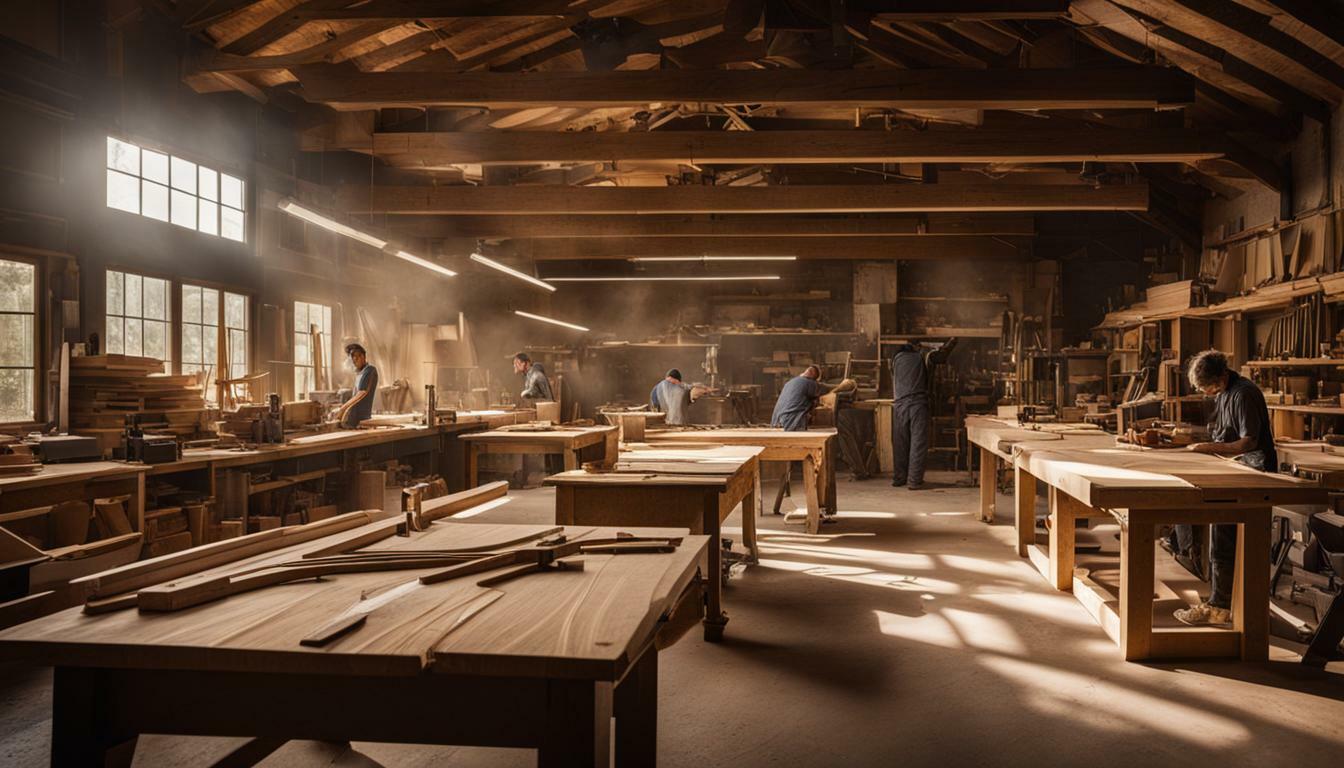Woodworking shops have the potential to be highly profitable businesses, but various factors influence their success. Market demand, niche specialization, quality craftsmanship, pricing strategies, efficient operations, effective marketing, competition with mass-manufactured wood crafts, producing unique and in-demand items, specializing in profitable niches, and building a strong brand image all play essential roles in determining the profitability of woodworking businesses.
Key Takeaways:
- Market demand and identifying a niche or specialization are crucial for maximizing profitability in woodworking businesses.
- Offering unique, high-quality products and superior craftsmanship allows for higher pricing and increased profitability.
- Pricing strategies should consider costs and competitor prices to optimize profitability.
- Efficient operations, including inventory management and production processes, can maximize profitability.
- Effective marketing and brand promotion through social media and partnerships attract customers and increase sales.
Market Demand and Niche Specialization
The profitability of woodworking shops heavily relies on market demand and the ability to find a unique niche or specialization. In order to make money with woodworking, it is important to understand the current trends and demands in the market. By catering to the needs and preferences of customers, woodworking businesses can attract a steady stream of clients and increase their income.
Identifying a niche or specialization is key to standing out in a saturated market. By offering unique products or services that are not readily available elsewhere, woodworking businesses can capture the attention of customers who are looking for something different and personalized. Whether it’s custom furniture, handcrafted home decor, or specialty woodworking tools, finding a profitable niche can boost the profitability of a woodworking shop.

When it comes to making money with woodworking, quality and craftsmanship are essential factors. Customers are willing to pay a premium for products that are well-made and showcase superior craftsmanship. By focusing on producing high-quality items, woodworking businesses can command higher prices and increase their profitability. Emphasizing attention to detail, using premium materials, and incorporating unique designs can set a woodworking shop apart from competitors.
Table: Factors Contributing to Woodworking Shop Profitability
| Factors | Description |
|---|---|
| Market Demand | Identify trends and cater to customer preferences to attract a steady stream of clients. |
| Niche Specialization | Offer unique products or services that are not readily available elsewhere to stand out in the market. |
| Quality and Craftsmanship | Focus on producing high-quality items that showcase superior craftsmanship to command higher prices. |
| Pricing Strategies | Consider all associated costs and competitor prices to determine optimal pricing for maximum profitability. |
| Efficient Operations | Streamline inventory management and production processes to minimize costs and maximize profitability. |
| Effective Marketing and Brand Promotion | Utilize social media, partnerships, and other marketing strategies to attract customers and increase sales. |
| Competition with Mass-Manufactured Wood Crafts | Overcome challenges of competing with low-priced mass-manufactured wood crafts by offering unique and in-demand items. |
| Specializing in Profitable Niches | Focus on profitable niches to enhance the success and profitability of a woodworking shop. |
| Building a Strong Brand Image | Create a recognizable brand that attracts customers and increases profitability for a woodworking shop. |
By considering these factors and implementing strategies to capitalize on market demand, woodworking shops can increase their profitability and establish themselves as successful businesses in the industry.
Quality and Craftsmanship
Offering high-quality products and superior craftsmanship can set woodworking shops apart and contribute to higher profitability. Customers are willing to pay a premium for well-crafted and meticulously finished woodworking items. This emphasis on quality not only attracts customers but also helps to build a strong reputation for the woodworking business.
Woodworkers who take pride in their workmanship often gain a loyal customer base that appreciates the attention to detail and the longevity of their products. By focusing on creating unique and durable items, woodworkers can establish themselves as trusted experts in the field. This trust translates into repeat business and word-of-mouth referrals, both of which are vital for sustained profitability.
Furthermore, quality craftsmanship allows woodworking businesses to command higher prices for their products. Customers recognize the value of handcrafted items that showcase intricate designs and meticulous attention to detail. This ability to justify higher prices creates room for increased profit margins, contributing to the overall profitability of the business.
In summary, quality and craftsmanship play a significant role in the profitability of woodworking shops. By offering high-quality products, personalized designs, and superior craftsmanship, woodworking businesses can differentiate themselves in the market, command higher prices, and attract a loyal customer base.
“Craftsmanship isn’t just about making something well; it’s about making something extraordinary.”
– Marc Adams, Woodworking Expert
The Importance of Quality and Craftsmanship
When it comes to woodworking, quality and craftsmanship are the cornerstones of success. Woodworkers who prioritize these aspects not only create beautiful and functional pieces but also establish themselves as leaders in the industry. By focusing on delivering exceptional quality, woodworking businesses can boost their profitability and secure long-term success.
| Benefit of Quality and Craftsmanship | Impact on Profitability |
|---|---|
| Building a strong reputation | Attracts more customers and fosters brand loyalty |
| Ability to charge higher prices | Increases profit margins |
| Generates word-of-mouth referrals | Brings in additional business without marketing expenses |
| Creates long-lasting and durable products | Reduces customer complaints and returns, ensuring customer satisfaction |
Pricing Strategies
Implementing effective pricing strategies is crucial for woodworking entrepreneurs to ensure profitable operations. By carefully considering all associated costs and competitor prices, woodworking shops can set prices that maximize profitability while remaining competitive in the market.
One strategy to consider is value-based pricing, where the price is determined by the perceived value of the product or service. Woodworking businesses can emphasize the unique features, superior craftsmanship, and personalized designs of their products to justify higher prices. This approach appeals to customers who are willing to pay a premium for quality and exclusivity.
Pricing Strategy Example: Value-Based Pricing
| Product | Cost to Produce | Competitor Prices | Value-Based Price |
|---|---|---|---|
| Handcrafted Wooden Table | $200 | $300 | $400 |
| Custom Carved Wooden Sign | $50 | $80 | $100 |
| Antique Reproduction Chair | $300 | $500 | $600 |
Another approach is cost-plus pricing, where the price is determined by adding a desired profit margin to the cost of production. This strategy ensures that all expenses are covered and allows for a predictable profit. However, it is important to regularly review and adjust prices based on changes in costs and market conditions.
Woodworking entrepreneurs should also consider dynamic pricing, particularly for one-of-a-kind or limited edition items. By creating a sense of urgency and exclusivity around these products, shops can charge higher prices. This strategy can be effective for generating higher profits, especially if the demand exceeds the supply.
By implementing thoughtful pricing strategies, woodworking entrepreneurs can position their businesses for profitability while delivering value to their customers.

Efficient operations play a vital role in the profitability of woodworking shops and contribute to overall business success. By streamlining processes and optimizing resources, woodworking businesses can increase productivity and reduce costs. This results in higher profit margins and a competitive edge in the market.
One key aspect of efficient operations is effective inventory management. By carefully tracking materials, tools, and finished products, woodworkers can minimize waste, avoid stockouts, and optimize cash flow. This not only ensures a smooth production process but also prevents financial losses due to excess inventory or missed sales opportunities.
Furthermore, optimizing production processes can significantly impact profitability. By analyzing workflows, identifying bottlenecks, and implementing lean manufacturing principles, woodworking shops can enhance efficiency and reduce lead times. This allows for faster order fulfillment, improved customer satisfaction, and increased revenue.
In addition to internal operations, outsourcing certain tasks can also contribute to efficiency and profitability. Woodworkers often partner with specialized suppliers or subcontractors to access cost-effective materials and services. This eliminates the need for in-house production of non-core items, allowing businesses to focus on their core strengths and save time and resources.

By prioritizing efficient operations, woodworking shops can optimize resources, minimize waste, and deliver high-quality products in a timely manner. This not only boosts profitability but also enhances customer satisfaction and builds a strong reputation in the woodworking industry. To stay competitive and achieve long-term success, woodworking businesses must continuously evaluate and improve their operations to adapt to changing market demands and technological advancements.
Table: Key Factors for Efficient Operations in Woodworking Shops
| Factor | Description |
|---|---|
| Inventory Management | Efficient tracking and control of materials and finished products to minimize waste and ensure timely availability. |
| Production Process Optimization | Analyzing workflows, identifying bottlenecks, and implementing lean manufacturing principles to enhance efficiency. |
| Outsourcing and Partnerships | Collaborating with specialized suppliers or subcontractors to access cost-effective materials and services. |
| Continuous Improvement | Regular evaluation and refinement of operations to adapt to evolving market demands and technological advancements. |
By incorporating efficient operations into their business strategies, woodworking shops can optimize profitability and ensure long-term success. Through effective inventory management, production process optimization, outsourcing, and continuous improvement, woodworkers can maximize productivity, minimize costs, and deliver exceptional products to meet customer demands.
Effective Marketing and Brand Promotion
Implementing effective marketing strategies and building a strong brand image are essential for woodworking businesses to achieve profitability. In today’s competitive market, it is crucial to stand out from the crowd and attract customers who appreciate the value and craftsmanship of handmade wood products.
One effective way to promote your woodworking business is through social media platforms. Create engaging content that showcases your products, process, and the unique stories behind each piece. Use high-quality images and videos to captivate your audience and encourage them to explore your offerings.
Additionally, forming partnerships with complementary businesses can expand your reach and attract new customers. Collaborating with interior designers, home decor stores, or even local artisans can help you tap into new markets and increase your woodworking shop income.

| Marketing Strategies | Benefits |
|---|---|
| Social media campaigns | Reach a wider audience and showcase your craftsmanship |
| Partnerships | Expand your customer base and tap into new markets |
| Email marketing | Maintain customer relationships and promote new products |
Furthermore, email marketing can be a powerful tool for nurturing customer relationships and promoting new products. Collect email addresses from your website visitors or in-store customers and send regular newsletters with updates, special offers, and personalized recommendations.
Remember, building a strong brand image is not just about advertising; it’s about creating a cohesive identity that resonates with your target audience. Consistency in your messaging, visuals, and customer interactions will instill trust and loyalty, ultimately leading to increased woodworking business profitability.
Competition with Mass-Manufactured Wood Crafts
Small woodworking businesses often struggle to compete with mass-manufactured wood crafts sold at low prices, impacting their profitability. In today’s market, consumers have access to a wide range of affordable wood products that are readily available at big-box retailers or online platforms. These mass-produced items are often manufactured in bulk, allowing the manufacturers to offer them at lower prices than what individual woodworking shops can afford to sell their handmade creations for. This creates a challenge for small businesses, as they must find ways to differentiate themselves and emphasize the value of their unique, handcrafted products.
One strategy for small woodworking businesses to overcome this challenge is by focusing on producing unique and in-demand items that are not readily available in the market. By tapping into niche markets and identifying what customers are looking for, these businesses can create products that stand out and offer something different from mass-manufactured alternatives. This can include specialized designs, customized furniture pieces, or one-of-a-kind decorative items that cater to specific customer preferences or trends. By offering something unique and desirable, woodworking shops can attract customers who value the craftsmanship and individuality of handmade products.
In addition to focusing on uniqueness, small woodworking businesses can also emphasize the quality and craftsmanship of their products. Handmade wood crafts often carry an inherent level of quality that mass-produced items may lack. By highlighting the attention to detail, the use of high-quality materials, and the superior craftsmanship that goes into each piece, businesses can position themselves as providers of premium products that are worth the investment. This allows them to justify higher price points and differentiate themselves from the mass market.
| Benefits | Challenges |
|---|---|
|
|
By focusing on creating unique, high-quality products and effectively communicating their value to customers, small woodworking businesses can carve out a profitable niche in the market. While the competition with mass-manufactured wood crafts may be challenging, the demand for unique and handcrafted items continues to exist. By leveraging their creativity, craftsmanship, and the inherent value of handmade products, woodworking shops can thrive and build a loyal customer base that appreciates the artistry and individuality of their creations.

Woodworking businesses face challenges in competing with mass-manufactured wood crafts sold at low prices. However, by producing unique, high-quality products and emphasizing their craftsmanship, these businesses can differentiate themselves and cater to customers who value the artistry and individuality of handmade wood crafts. While the mass market offers affordable options, there is a niche market that appreciates the value of handmade items. By tapping into this market and effectively communicating the value of their products, woodworking businesses can carve out a profitable niche and thrive in the industry.
Producing Unique and In-Demand Items
To boost profitability, woodworking shops should focus on producing unique and in-demand items that cater to customer preferences. Standing out in a crowded market requires offering products that are different from what is readily available. By creating one-of-a-kind pieces that showcase craftsmanship and innovation, woodworking businesses can attract customers seeking something special.
Customization is key in capturing customer interest and increasing sales. Offering personalized designs and the ability to customize orders allows customers to feel a sense of ownership and connection to the products they purchase. This can lead to higher customer satisfaction and repeat business. By prioritizing unique and customizable items, woodworking shops can position themselves as the go-to destination for customers seeking exclusive, high-quality woodwork.

In addition to uniqueness, identifying and producing in-demand items is crucial for maximizing profitability. Researching current market trends and understanding customer preferences can provide insights into the types of woodworking projects that are currently sought after. By aligning their product offerings with market demand, woodworking businesses can effectively capitalize on profitable opportunities.
| Key Factors for Producing Unique and In-Demand Items: |
|---|
| 1. Conduct market research to identify current trends and customer preferences. |
| 2. Offer customization options to cater to individual customer needs. |
| 3. Showcase craftsmanship and innovation through unique designs. |
| 4. Experiment with different materials, finishes, and woodworking techniques to create distinctive products. |
| 5. Stay up-to-date with industry developments and adapt product offerings accordingly. |
By focusing on producing unique and in-demand items, woodworking businesses can set themselves apart from competitors and increase their profitability. Combining exceptional craftsmanship, personalized designs, and market research-driven strategies, woodworking shops can thrive in an industry that values creativity and innovation.
Specializing in Profitable Niches
Specializing in profitable niches can significantly enhance the profitability and overall success of woodworking businesses. By focusing on specific areas where there is high demand and limited competition, you can establish yourself as an expert in that niche and attract a dedicated customer base.
One strategy to identify profitable niches is to conduct market research and analyze trends. Look for gaps in the market or emerging customer needs that are not being fulfilled. For example, you might discover a growing demand for eco-friendly and sustainable wood products. By specializing in crafting unique and environmentally friendly items, you can position yourself as an ethical woodworking business, appealing to a conscious consumer base.
Another approach is to target a specific customer group or industry. For instance, you could specialize in creating custom-made furniture for luxury hotels or high-end residential properties. By understanding the needs and preferences of your target market, you can tailor your products and services to meet their specific requirements, allowing you to charge premium prices and achieve higher profit margins.
Table 1: Examples of Profitable Woodworking Niches
| Niche | Description |
|---|---|
| Eco-friendly woodworking | Creating sustainable wood products using environmentally-friendly practices. |
| Custom furniture for luxury homes | Designing and crafting high-end, personalized furniture pieces for affluent clientele. |
| Wooden toys and games | Producing handcrafted, safe, and educational wooden toys and games for children. |
Remember, the key to success in profitable niches is to offer unique and high-quality products that meet the specific needs of your target market. This will help differentiate your woodworking business from competitors and create a strong value proposition for customers. By specializing in profitable niches, you can position yourself for long-term success and maximize the profitability of your woodworking business.

Establishing a strong brand image is key to attracting customers and increasing profitability for woodworking businesses. Your brand identity should reflect the unique aspects of your woodworking shop and resonate with your target audience. By effectively communicating your values, expertise, and commitment to quality, you can differentiate yourself from competitors and build a loyal customer base.
One way to enhance your brand image is through storytelling. Craft a compelling narrative that showcases the passion and craftsmanship behind your woodworking business. Share the story of how you got started, highlight the materials and techniques you use, and emphasize the care and attention to detail that goes into each piece. This personal connection with your audience can create a sense of trust and authenticity, making customers more willing to invest in your products.
Another important aspect of building a strong brand image is consistent visual branding. This includes your logo, color palette, typography, and overall design aesthetic. These elements should be visually appealing and reflective of your woodworking style. Use them consistently across all your marketing materials, including your website, social media profiles, packaging, and signage. Consistency in branding helps establish recognition and increases brand recall, making it easier for customers to remember and recommend your woodworking shop.
Additionally, customer reviews and testimonials can play a significant role in strengthening your brand image. Encourage satisfied customers to leave reviews on your website or popular review platforms. Highlight positive feedback and showcase customer testimonials on your website or social media. These testimonials act as social proof, giving potential customers confidence in your woodworking skills and the quality of your products.
Table: Brand Building Checklist
| Brand Building Checklist | Status |
|---|---|
| Create a memorable logo that represents your woodworking shop’s identity | ✓ |
| Develop a consistent color palette and typography for your brand | ✓ |
| Tell your woodworking shop’s unique story through engaging content | ✓ |
| Showcase customer testimonials and positive reviews on your website | ✓ |
| Use social media platforms to engage with your audience and share updates | ✓ |
| Create consistent and visually appealing marketing materials | ✓ |
Building a strong brand image requires time, effort, and consistency. Stay true to your values and focus on delivering exceptional woodworking products and services. As your brand reputation grows, you’ll attract more customers who appreciate your craftsmanship and are willing to pay a premium for your unique creations. Remember, a strong brand can be the foundation for long-term success and profitability in the woodworking industry.

In conclusion, while woodworking shops have the potential to be profitable businesses, success depends on various factors such as market demand, niche specialization, quality, pricing strategies, efficient operations, effective marketing, and creating a strong brand image. By focusing on these aspects and producing unique and in-demand items, woodworking entrepreneurs can maximize their earnings and achieve profitability.
Market demand plays a crucial role in the success of woodworking shops. Identifying a niche or specialization can help differentiate a woodworking business and cater to specific customer needs. Offering unique and high-quality products, personalized designs, and superior craftsmanship can allow for higher pricing and increased profitability. By prioritizing quality, woodworking businesses can build a loyal customer base and increase their chances of success.
Pricing strategies should consider all associated costs and competitors’ prices. It’s important to find the right balance between profitability and competitiveness. Efficient operations, including effective inventory management and streamlined production processes, can help reduce costs and maximize profitability. By optimizing operations, woodworking shops can increase their bottom line and ensure smooth business operations.
Effective marketing and brand promotion are crucial for attracting customers and increasing sales. Utilizing social media platforms, partnering with relevant influencers or complementary businesses, and implementing targeted advertising campaigns can help reach a wider audience and generate more revenue. By creating a strong brand image, woodworking businesses can differentiate themselves and build a trusted reputation in the market.
However, it can be challenging for small woodworking businesses to compete with mass-manufactured wood crafts at low prices. To overcome this obstacle, woodworkers should focus on producing unique, in-demand items that are not readily available in the market. By offering specialized products, woodworking businesses can attract customers who value craftsmanship and are willing to pay a premium for quality and exclusivity.
Specializing in profitable niches can also contribute to the success and profitability of woodworking shops. By identifying untapped markets or specific customer needs, woodworking entrepreneurs can position themselves as experts in their chosen niche and cater to a dedicated customer base. This focus allows for better resource allocation and targeted marketing efforts, resulting in higher profitability.
Building a strong brand image is essential for long-term success. By consistently delivering high-quality products, providing excellent customer service, and maintaining a consistent brand identity, woodworking businesses can establish themselves as trustworthy and reliable. This can lead to repeat customers, positive word-of-mouth, and increased profitability in the long run.
In summary, woodworking shops have the potential to be profitable businesses. By considering market demand, specializing in a niche, prioritizing quality, implementing effective pricing strategies, optimizing operations, conducting strategic marketing efforts, and building a strong brand image, woodworking entrepreneurs can maximize their earnings and achieve profitability.
FAQ
Q: Are woodworking shops profitable?
A: Woodworking shops have the potential to be profitable, but success depends on various factors. Market demand, niche specialization, quality, craftsmanship, pricing strategies, efficient operations, effective marketing, competition, producing unique items, specializing in profitable niches, and building a strong brand image all contribute to the profitability of woodworking shops.
Q: How can market demand and niche specialization impact woodworking shop profitability?
A: Market demand plays a crucial role in woodworking shop profitability. Identifying a niche or specialization allows for differentiation in the market and can attract customers looking for unique woodworking products. By catering to specific customer needs and preferences, woodworking shops can increase sales and profitability.
Q: How does quality and craftsmanship contribute to woodworking shop profitability?
A: Offering unique and high-quality products, personalized designs, and superior craftsmanship allows woodworking shops to command higher prices and attract customers who value craftsmanship. By providing exceptional woodworking services and products, shops can increase profitability through customer satisfaction and word-of-mouth referrals.
Q: How should pricing strategies be considered in maximizing woodworking shop profitability?
A: Pricing strategies should consider all associated costs, including materials, labor, overhead, and desired profit margins. Researching competitors’ prices and finding a balance between affordability and profitability is essential. By accurately pricing products and services, woodworking shops can optimize profitability.
Q: How can efficient operations maximize woodworking shop profitability?
A: Efficient operations, including inventory management and streamlined production processes, minimize waste, reduce costs, and improve overall productivity. By maximizing efficiency, woodworking shops can allocate resources effectively and increase profitability.
Q: How can effective marketing and brand promotion impact woodworking shop profitability?
A: Effective marketing and brand promotion, such as through social media and partnerships, can attract customers and increase sales. By creating a strong brand presence and effectively communicating the unique value proposition of the woodworking shop, profitability can be enhanced through increased customer awareness and loyalty.
Q: How can woodworking shops overcome competition with mass-manufactured wood crafts?
A: Small woodworking businesses can overcome competition with mass-manufactured wood crafts by producing unique, in-demand items that are not readily available in the market. By focusing on specialization, quality, craftsmanship, and offering personalized designs, woodworking shops can differentiate themselves and attract customers willing to pay a premium for customized and high-quality products.
Q: Why is specializing in profitable niches important for woodworking shop profitability?
A: Specializing in profitable niches allows woodworking shops to target specific customer segments and cater to their unique needs and preferences. By becoming experts in a particular niche, shops can establish themselves as go-to destinations for customers seeking specialized woodworking products or services, leading to increased profitability.
Q: How does building a strong brand image contribute to woodworking shop profitability?
A: Building a strong brand image allows woodworking shops to differentiate themselves from competitors and attract more customers. By developing a unique brand identity, communicating brand values, and establishing a reputation for quality and reliability, shops can increase customer loyalty, attract new customers, and ultimately enhance profitability.
What Factors Contribute to the Profitability of Woodworking?
One of the key factors that contribute to the profitability of selling woodworking for profit is the quality of craftsmanship. Attention to detail, precision, and skill in creating beautifully crafted wood products can significantly impact the demand and price. Additionally, understanding market trends, effective marketing strategies, and cost management play vital roles in maximizing profitability within the woodworking industry.

